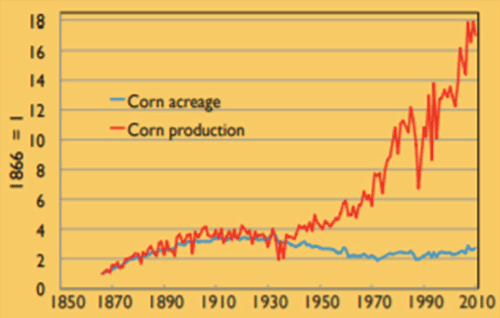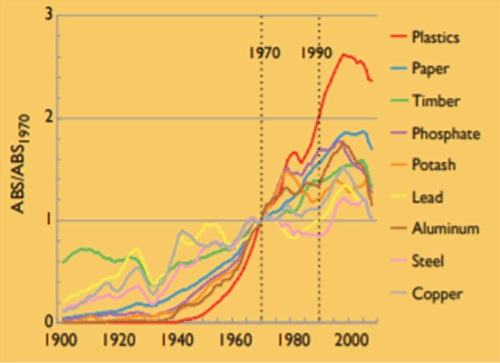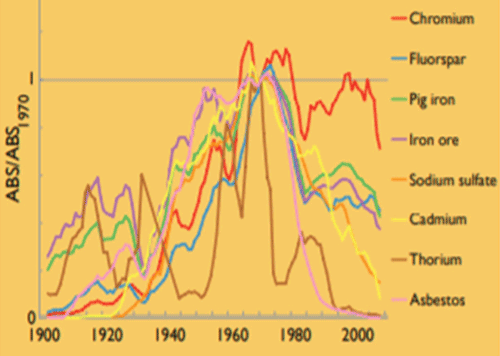
Looking on the Bright Side
-
 John Mauldin
John Mauldin
- |
- January 17, 2020
- |
- Comments
- |
- View PDF
We haven’t had a lot of good news lately. Or, more precisely, we haven’t seen a lot of good news lately, though it does exist. We don’t see it because both regular media and social media usually focus on the bad.
That’s not entirely wrong. The survival imperative makes humans watch for threats, and sometimes threats are real. I write about them often, most recently in my Decade of Living Dangerously forecast (see Part 1 and Part 2). Yet good things are happening, too, and will keep happening as we move through the 2020s. Occasionally I like to note them, and that’s what we will do today.
I often say I’m short-term bearish and long-term bullish, but I’m not short-term bearish on everything. Positive events are occurring right now, all over the world. Lives are being saved, living standards are rising, children are learning. Good and bad can happen concurrently, sometimes in the same place. It’s not either/or.
Looking on the bright side also helps us discern the future. Things that work are usually things that will sell. When someone solves an important problem, it might be an investment opportunity.
So, let’s review some good news.
But first, at one point I had a connection to Bridgewater and Ray Dalio, but that email seems to have stopped working. I want to invite Ray to speak at my conference and be part of a documentary series on how we address the problems he’s highlighted. If someone from Bridgewater (I know some of you read my letter) or elsewhere could connect us, please contact my staff. I don’t want to be a bother…
Disappearing Stuff
We’ll start with the man who literally wrote the book on optimism, Matt Ridley. He explained in The Rational Optimist how history shows the world getting constantly better even as bad things happen. This shouldn’t surprise us. It’s actually quite normal.
In a Spectator column last month, Matt zeroed in on a common fallacy. Some people think all our technology and progress simply generate more “stuff” that harms the environment and eventually us, too. Certainly, some of our stuff is harmful. But the broader idea—that we consume too much—is simply wrong. We are consuming less. Here’s Ridley.
In 2011 Chris Goodall, an investor in electric vehicles, published research showing that the UK was now using not just relatively less ‘stuff’ every year, but absolutely less. Events have since vindicated his thesis. The quantity of all resources consumed per person in Britain (domestic extraction of biomass, metals, minerals and fossil fuels, plus imports minus exports) fell by a third between 2000 and 2017, from 12.5 tonnes to 8.5 tonnes. That’s a faster decline than the increase in the number of people, so it means fewer resources consumed overall.
If this doesn’t seem to make sense, then think about your own home. Mobile phones have the computing power of room-sized computers of the 1970s. I use mine instead of a camera, radio, torch, compass, map, calendar, watch, CD player, newspaper and pack of cards. LED light bulbs consume about a quarter as much electricity as incandescent bulbs for the same light. Modern buildings generally contain less steel and more of it is recycled. Offices are not yet paperless, but they use much less paper.
Even in cases when the use of stuff is not falling, it is rising more slowly than expected. For instance, experts in the 1970s forecast how much water the world would consume in the year 2000. In fact, the total usage that year was half as much as predicted. Not because there were fewer humans, but because human inventiveness allowed more efficient irrigation for agriculture, the biggest user of water.
Until recently, most economists assumed that these improvements were almost always in vain, because of rebound effects: if you cut the cost of something, people would just use more of it. Make lights less energy-hungry and people leave them on for longer. This is known as the Jevons paradox, after the 19th-century economist William Stanley Jevons, who first described it. But Andrew McAfee argues that the Jevons paradox doesn’t hold up. Suppose you switch from incandescent to LED bulbs in your house and save about three-quarters of your electricity bill for lighting. You might leave more lights on for longer, but surely not four times as long.
Efficiencies in agriculture mean the world is now approaching ‘peak farmland’—despite the growing number of people and their demand for more and better food, the productivity of agriculture is rising so fast that human needs can be supplied by a shrinking amount of land. In 2012, Jesse Ausubel of Rockefeller University and his colleagues argued that, thanks to modern technology, we use 65 per cent less land to produce a given quantity of food compared with 50 years ago. By 2050, it’s estimated that an area the size of India will have been released from the plough and the cow.
I’ve actually had a number of conversations personally with good friend and brilliant scientist Jesse Ausubel (mentioned above) about this. The late, great Andy Marshall of the Pentagon’s Net Assessment Office invited us both to his Naval War College gatherings where we brainstormed possible future scenarios. Great times. Jesse and I still meet occasionally when I’m in New York.
Jesse wrote a very important report that I highlighted a few years ago (you can read it in our archives). He explains how things are getting better by almost every measurable statistic. We are using less water to grow the same amount of food. “Water withdrawals” for agricultural purposes have been flat since 1975 while production of corn and soybeans has grown 300%, wheat 60%, and potatoes 25%. The chart below shows that we are producing about five times the amount of corn per acre vs. 70 years ago. We are literally feeding a good portion of the world, and using less land to do so.
Interestingly, the use of fertilizer skyrocketed from 1940 to about 1970 and then plateaued and is actually beginning to fall. So we’re producing far more with less fertilizer.

Source: Jesse Ausubel
It’s not just corn. You can see the same in potatoes or any other crop. Jesse argues that the world is at “peak farmland,” and will be able to feed a growing world population using current acreage or less.
Forests and woodlands have expanded in the past 50 years, and are still doing so. It is hard for us to imagine that around 1900 Connecticut had almost no forest. Logging, farming, livestock, and other human activities had decimated the forests. Yet today you can fly over Connecticut and all over New England and see large, lush, forested areas. One reason is that humans are using 70% less wood for fuel. Wood used for paper is about the same, but comes from far more efficiently managed forests.
In fact, we have seen consumption of many basic commodities peak and begin to fall over the last 10–20 years.


Source: Jesse Ausubel
Air quality is improving all over the US and Europe, and actually most of the developed world and much of the developing world. In the US, despite dramatic population and GDP growth in the past 50 years, sulfur emissions dropped 50%. That is absolutely stunning when you think about it.
The impact isn’t just on land. Here in the US, dolphins now inhabit the once-polluted Potomac River for the first time since the 1880s. The urbanization we sometimes decry (with good reasons) has a bright side. Concentrating most people in small areas reduces population density elsewhere, giving wildlife space to flourish.
Like what you're reading?
Get this free newsletter in your inbox every Saturday! Read our privacy policy here.
Of course we have environmental challenges. But we’re learning to reduce our impact and share the planet with other creatures. I should note that, despite general optimism, Jesse Ausubel is extremely concerned for oceans and fish populations. As an example, Cape Cod’s total cod population today is a fraction of where it was two centuries ago. The pollution in the ocean is simply disgusting in many places. There are frankly some cities in Asia where I do not want to eat locally caught fish. The concerns about mercury and tuna aren’t imaginary.
We have plenty of room to do better… but we’re doing a lot.
|
Saved Lives
You can find a treasure trove of positivity at Future Crunch’s Good News page. They collect short snippets with links to the original sources. You can spend days clicking through to fascinating info. It’s really good therapy if you’re discouraged about the world. I look forward to getting their email every week or so.
Many of the stories are about medical breakthroughs. The number of diseases we are learning to control, cure, or even eliminate is staggering.
- In the UK, most people diagnosed with late-stage melanoma 10 years ago would die within months. Only one in 20 lived five years. Now the five-year survival rate is 52%, or 10 times higher than it was a decade ago, thanks to new treatments.
- The US Food & Drug Administration last year approved a new cystic fibrosis drug combination that shows amazing results. It doesn’t just relieve symptoms but attacks the disease’s genetic root. The Washington Post reports, “Patients who were unsure about whether they should bother attending college because they had always known they would die young are now being told they should think about planning for retirement.” (I am personally quite familiar with this drug as one of my biotech investments owns a significant chunk of it. With 2020 hindsight (pardon the pun), I wish I had bought a great deal more.)
- In the US we think of pneumonia as an older-people condition, but worldwide it is a major child killer. As recently as the 1990s, pneumonia killed more than two million children a year. That number has since dropped by almost two-thirds, thanks to better treatments as well as wider vaccination against the pathogens that cause it. The death rates are still far too high, but science is saving millions of young lives.
- The terrifying Ebola virus is on the run. The disease that once killed thousands of Africans and threatened to spread quickly through airports around the world is becoming treatable. A new triple-antibody cocktail developed by US scientists reduces the mortality rate from 70% to as low as 6% when administered early enough.
- The number of malaria cases in India dropped 50% from 2017 to 2018, and mortality decreased among the smaller number of people who were infected. A lot of it comes from simple mosquito nets reaching people who never had them. Treatments improved as well.
- The American Cancer Society just reported the largest-ever one-year drop in the US cancer death rate, driven mainly by lower lung cancer mortality. Newer drugs, better surgical techniques, and better diagnosis are all helping.
I am personally following a private company (Bexion Pharmaceuticals) which is now in phase 2 trials for what looks like a “silver bullet” against all types of tumors. They are now focusing on brain tumors, pancreatic and recently colorectal cancer. I truly believe we will see cancer become a treatable nuisance by 2030. (Disclosure: I have an investment in Bexion. I now think the greater risk to my investment isn’t whether the drug works, as the evidence is pretty strong that it does, but that other therapies may be better, faster, and less expensive.)
I could list dozens of similar stories. Many more breakthroughs are coming, too, some even more impressive. They will help you even if yours isn’t one of the lives saved. People and their brains are the most important natural resource. If not stopped by disease, they become workers, have families, and occasionally do things to change the world.
And that’s before the impact of new therapies on aging and what I believe will be actual age reversal by the end of this decade or the mid-2030s at the latest. Pat Cox and I are currently exploring the possibility of funding some of these ventures.
Unlocking the Door
We are making progress above the Earth, too. If all goes well, NASA could send astronauts back to space this year for the first time since the space shuttle retired in 2011. They’ve been relying on Russian rockets for manned flights.
Several countries will be launching Mars probes this year, including another US rover that will carry a small helicopter, Yes, a robot helicopter flying over Mars. Did you imagine living long enough to see such a thing?
Perhaps even more exciting, private companies could soon start taking private passengers to space—or at least the edge of it. Richard Branson’s Virgin Galactic and Blue Origin, founded by Jeff Bezos, are in advanced testing.
But the biggest breakthrough doesn’t involve sending anyone anywhere. Two companies, SpaceX and OneWeb, are building large networks of low-orbiting satellites to deliver seamless, fast internet service across the entire globe. That may seem like a small thing. It’s actually huge.
Depending on whose numbers you consult, something like half the world population still doesn’t have reliable web access. Often it’s because they live in remote areas where the infrastructure doesn’t exist and no one has a financial interest in building it. The new satellites could change the economics. Google’s high balloon project is making significant headway, too.
Getting the rest of the world online matters because among these disconnected billions are people whose ideas and talents could create even more breakthroughs. This vast, untapped resource will be a whole new market for today’s businesses and others that we can’t presently imagine. By 2030 I expect we will have unlocked that door and had a peek inside.
A Better World, by the Numbers
The late Swedish professor Hans Rosling’s book Factfulness: 10 Reasons Why We Are Wrong About the World and Why Things Are Better Than You Think is a masterpiece everyone should read. He describes our evolutionary bias to think in dichotomies: good versus evil, heroes versus villains, my country versus yours.
Dividing the world into two distinct sides is simple and intuitive, and also dramatic because it implies conflict, and we do it without thinking, all the time.
Journalists know this. They set up their narratives as conflicts between two opposing people, views, or groups… Journalists are storytellers.
We evolved as a species sitting around fires, hearing other people tell stories. It created trust and had an evolutionary purpose. And we still love our stories and storytellers. But the constant reminders of conflict and negativity infect our brains and bias our views. We extrapolate what we recently read or saw on the news to apply everywhere. It’s part of our dichotomous nature and called “recency bias.”
Rosling did a number of TED talks, but my favorite (and fun) is How Not to Be Ignorant About the World. He shows the enormous negative bias humans have about the world around them. We consistently assume things are worse than they actually are, while ignoring progress like the huge drop in global poverty.

Source: Our World in Data
Like what you're reading?
Get this free newsletter in your inbox every Saturday! Read our privacy policy here.
Child mortality is down significantly, as is the number of people without an improved drinking water source. Life expectancy is up everywhere (except for middle-age white males in the US). Genocide and war deaths are down significantly. So is crime in the US. The number of deaths from natural disasters plummeted well over 90% in the last hundred years. Death rates from air pollution are down significantly in the last 25 years.
I could go on many more pages about the world getting better. In fact, I will do so in my next book. But I hope you get the point: Good things are happening and we should celebrate them. It doesn’t mean we should ignore less pleasant realities, nor does it excuse us from helping those who need it right now. Some problems can’t wait.
We should do what humans always have: Welcome good when we see it, and face problems head-on. That’s how we will get through the Decade of Living Dangerously.
And here’s one more piece of good news: This year, we have added even more value to our most exclusive Mauldin Economics club, the Alpha Society.
New members will receive complimentary access to the SIC 2020, which will take place at the iconic Phoenician in Scottsdale, AZ, from May 11–14. They are also invited to our brand-new members-only event, the Wealth Preservation Symposium on March 31 at the Yale Club in New York City.
Add to that lifetime access to all of our best research, and you have an unbeatable package. However, we can only accept 100 new members at this time, so please apply now.
Miami and New York
I will make a quick trip to Miami next week to meet with Dr. Mike West of AgeX (where I am currently on the Board of Directors) to discuss some of the latest developments in the age reversal space. Stay tuned. And I still have to get to New York sooner rather than later.
Many readers know I use software called Dragon to dictate these letters straight into Microsoft Word. Sometimes, words get mixed up in strange ways. We call them Dragon errors and this letter had an amusing one.
Late last night when I said corn production was up 300%, Dragon heard it as “porn production.” My editor Patrick Watson noticed this and told me, “No, John, porn production is actually up more like 50X.” Anyway, he fixed it and I saw again why we still need human editors and proofers, even with the best technology.
This whole letter has felt like my personal section, because I truly am an optimist. I feel like I am letting that side of me out to share with my friends. I am really looking forward to 2020 and I’m glad you are with me.
And with that I will hit the send button and wish you a great week!
Your walking on the sunny side of the street analyst,
John Mauldin
P.S. If you like my letters, you'll love reading Over My Shoulder with serious economic analysis from my global network, at a surprisingly affordable price. Click here to learn more.
Put Mauldin Economics to work in your portfolio. Your financial journey is unique, and so are your needs. That's why we suggest the following options to suit your preferences:
-
John’s curated thoughts: John Mauldin and editor Patrick Watson share the best research notes and reports of the week, along with a summary of key takeaways. In a world awash with information, John and Patrick help you find the most important insights of the week, from our network of economists and analysts. Read by over 7,500 members. See the full details here.
-
Income investing: Grow your income portfolio with our dividend investing research service, Yield Shark. Dividend analyst Kelly Green guides readers to income investments with clear suggestions and a portfolio of steady dividend payers. Click here to learn more about Yield Shark.
-
Invest in longevity: Transformative Age delivers proven ways to extend your healthy lifespan, and helps you invest in the world’s most cutting-edge health and biotech companies. See more here.
-
Macro investing: Our flagship investment research service is led by Mauldin Economics partner Ed D’Agostino. His thematic approach to investing gives you a portfolio that will benefit from the economy’s most exciting trends—before they are well known. Go here to learn more about Macro Advantage.
Read important disclosures here.
YOUR USE OF THESE MATERIALS IS SUBJECT TO THE TERMS OF THESE DISCLOSURES.
Tags
Did someone forward this article to you?
Click here to get Thoughts from the Frontline in your inbox every Saturday.

 John Mauldin
John Mauldin
